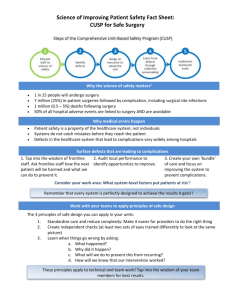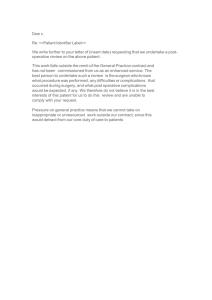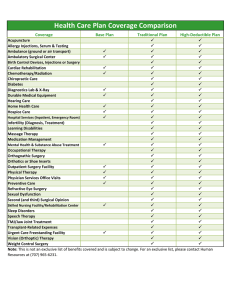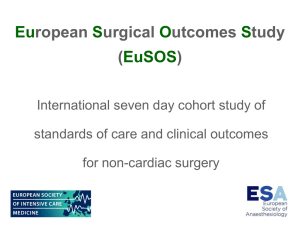Document 14233725
advertisement
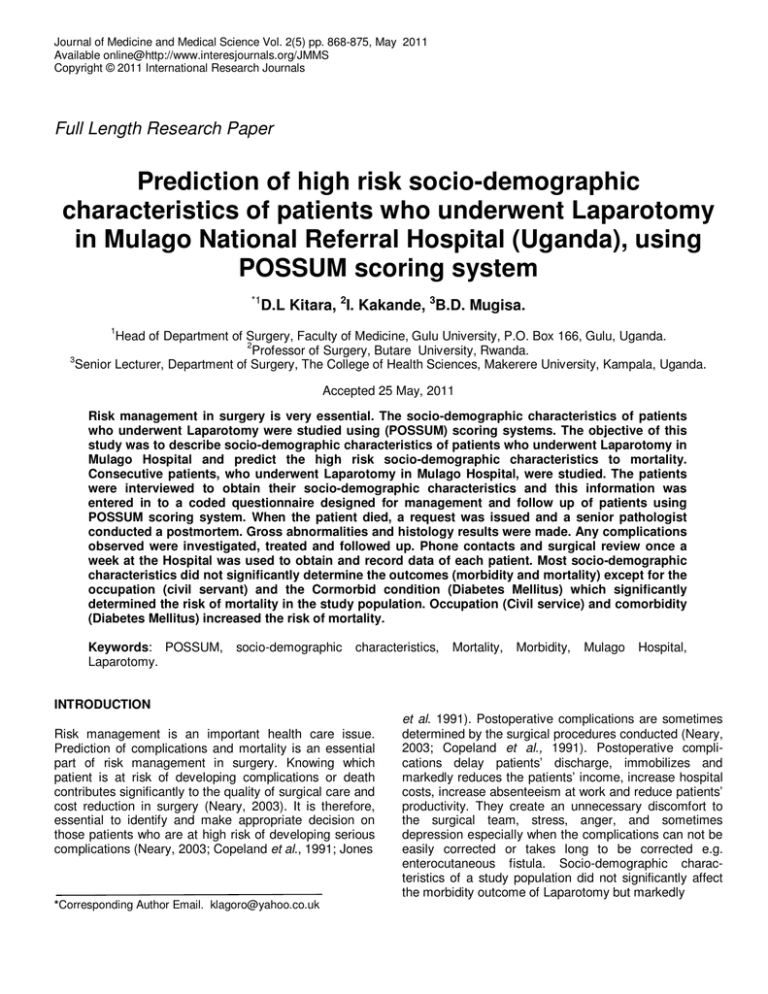
Journal of Medicine and Medical Science Vol. 2(5) pp. 868-875, May 2011 Available online@http://www.interesjournals.org/JMMS Copyright © 2011 International Research Journals Full Length Research Paper Prediction of high risk socio-demographic characteristics of patients who underwent Laparotomy in Mulago National Referral Hospital (Uganda), using POSSUM scoring system *1 D.L Kitara, 2I. Kakande, 3B.D. Mugisa. 1 Head of Department of Surgery, Faculty of Medicine, Gulu University, P.O. Box 166, Gulu, Uganda. 2 Professor of Surgery, Butare University, Rwanda. 3 Senior Lecturer, Department of Surgery, The College of Health Sciences, Makerere University, Kampala, Uganda. Accepted 25 May, 2011 Risk management in surgery is very essential. The socio-demographic characteristics of patients who underwent Laparotomy were studied using (POSSUM) scoring systems. The objective of this study was to describe socio-demographic characteristics of patients who underwent Laparotomy in Mulago Hospital and predict the high risk socio-demographic characteristics to mortality. Consecutive patients, who underwent Laparotomy in Mulago Hospital, were studied. The patients were interviewed to obtain their socio-demographic characteristics and this information was entered in to a coded questionnaire designed for management and follow up of patients using POSSUM scoring system. When the patient died, a request was issued and a senior pathologist conducted a postmortem. Gross abnormalities and histology results were made. Any complications observed were investigated, treated and followed up. Phone contacts and surgical review once a week at the Hospital was used to obtain and record data of each patient. Most socio-demographic characteristics did not significantly determine the outcomes (morbidity and mortality) except for the occupation (civil servant) and the Cormorbid condition (Diabetes Mellitus) which significantly determined the risk of mortality in the study population. Occupation (Civil service) and comorbidity (Diabetes Mellitus) increased the risk of mortality. Keywords: POSSUM, Laparotomy. socio-demographic characteristics, Mortality, Morbidity, Mulago Hospital, INTRODUCTION Risk management is an important health care issue. Prediction of complications and mortality is an essential part of risk management in surgery. Knowing which patient is at risk of developing complications or death contributes significantly to the quality of surgical care and cost reduction in surgery (Neary, 2003). It is therefore, essential to identify and make appropriate decision on those patients who are at high risk of developing serious complications (Neary, 2003; Copeland et al., 1991; Jones *Corresponding Author Email. klagoro@yahoo.co.uk et al. 1991). Postoperative complications are sometimes determined by the surgical procedures conducted (Neary, 2003; Copeland et al., 1991). Postoperative complications delay patients’ discharge, immobilizes and markedly reduces the patients’ income, increase hospital costs, increase absenteeism at work and reduce patients’ productivity. They create an unnecessary discomfort to the surgical team, stress, anger, and sometimes depression especially when the complications can not be easily corrected or takes long to be corrected e.g. enterocutaneous fistula. Socio-demographic characteristics of a study population did not significantly affect the morbidity outcome of Laparotomy but markedly Kitara et al. 869 determined the risk of mortality. Various studies have been conducted in Uganda to study the postoperative complications and mortality following Laparotomy. None of those studies have been by use of a scoring system such as (POSSUM). The objective of this study was to describe socio-demographic characteristics of patients who underwent Laparotomy in Mulago Hospital and use POSSUM scoring system to predict the high risk sociodemographic characteristics to mortality. PATIENTS AND METHODS This was a prospective descriptive study conducted over a period of 6-months in Mulago Hospital, Kampala, Uganda. The study population consisted of 76 patients aged 13 years and above who were admitted for elective and emergency surgery. Day-care surgery patients and those who died immediately before surgery were excluded. The patients were assessed preoperatively, operatively and postoperatively for any postoperative complications or death. During the six-months, 76 patients underwent emergency and elective Laparotomy in the Mulago Hospital Theatres. The patients were scored with the physiological component of POSSUM just before the induction of general anesthesia. Individual patients’ scores were computed and summed up to produce the POSSUM physiological score for each patient. The Laparotomies were conducted in the same technique and using midline incision. Intra-operative blood loss, type of surgery, the presence or absence of peritoneal soiling and intra-abdominal tumors were recorded. All these scores were computed and summed up for each patient to form the operative severity score. The closure of the abdomen was done using the same type of suture material and of equal suture size. The Follow-up of the patients was done up to 30th postoperative day. Patients were reviewed weekly in surgical outpatient department. Telephone and electronic mail contacts were used. In case of postoperative death, post-mortem examinations were conducted by a senior Pathologist at the Hospital. Statistical data analysis was conducted using the SPSS version 10.0 software. A student t-test was used to compare significant differences and chi-square/Fisher’s exact test was used in testing association of categorical variables. The quality control was ensured by the principal investigator carrying out all the pre-operative and postoperative assessment, clinical examinations and secondly measurements of parameters using standard International units (SI) to avoid inter-observer errors. Laboratory investigations were done by the same method and in standard units. The socio-demographic characteristics of the patients were entered into a pre set questionnaire and analyzed as described below. RESULTS The results of the study are shown in the tables and tables below. DISCUSSION Assessing the postoperative complications and causes of mortality after a Laparotomy is an important audit process with POSSUM scoring system. The socio-demographic characteristics of the patients were an important tool to assess whether they would in any way affect the outcome of Laparotomy. This was an effective method of assessing the risks of morbidity and mortality following Laparotomy in Mulago Hospital. Age The age of the patients ranged from 14 to 81 years (Figure 1). Only 7.8% of the patients were below the age of 20 years. The peak age incidence was between 20-29 years represented by 26.3% of the total population. This showed that most of the patients who underwent Laparotomy were those in the young age group. This was similar to findings of previous studies done in Mulago Hospital (Birabwa-Male, 1989) found in her series on abdominal trauma that the young age group constituted 32.9%, Mugisa (1988) found that 25% of his study population was within this age range. It should be noted that there were five patients above 70 years, constituting only 6.5% of the total study population. The majority of these older patients presented with intestinal obstruction mainly due to sigmoid volvulus in 60% and abdominal malignancy in 40%. A similar finding was observed by (Mugisa, 1988) where the elderly men commonly presented with sigmoid volvulus, the younger age group below 40 years commonly presented with blunt abdominal trauma with ruptured abdominal viscera. This age distribution shown above is consistent with the demographic data obtained in the last population census for Uganda 2001. The age of the patients did not significantly affect the physiological scores (t-value 0.061 and p-value 0.603). Similarly the operative score was not affected by the age (t= –0.019 and p= 0.873). A study in the USA indicated that increasing age was strongly associated with risk of complications but surprisingly, the risk declined for patients older than 79 years of age. The most likely explanation for the phenomenon was that there was a strong selection bias before hospitalization with older high-risk patients not being considered suitable for admission for surgery (Veltkamp et al., 2002). This observation was not made in this study probably because over 80% of the patients were below 40 years and so their age did not significantly affect the physiological score and therefore the outcome of surgery. 870 J. Med. Med. Sci. Figure 1: Age. Patient ages are range from 13 to 81 with a mean of 40.4 years and the peak age was between 20 to 29 years. The Sex Fifty two cases (52) of the seventy-six (76) i.e. 68.4 % of the total population were males (Figure 2). The majority of these male patients presented with blunt abdominal trauma (ruptured viscera) (14 cases), abdominal malignancy, intestinal obstruction and appendicitis (5) in descending order. Appendicitis presented in equal proportion between the male (5) and females (5). There were no male patients who presented with surgical jaundice. This probably confirms the fact that surgical jaundice is fewer in males compared to the females. The sex of the patient did not influence the outcome of surgery. A recent study in the USA autopsy series have shown gall stones in at least 20% in women and in only 8% in males over the age of 40 years. There was however no correlation between sex and physiological and operative scores. There was also no relationship between sex and outcome (morbidity and mortality). The Tribes Among the study population, 57% (44 out of 76) of the patients were Baganda (Figure 3). This is not unusual because the Baganda forms the majority of the Ugandan population and it should also be noted that Mulago Hospital is situated in Buganda land. It is not therefore surprising to find that the majority of the patients studied were Baganda. However there were other tribes such as Basoga (6.6%), Banyankole (9.2%), Acholi (2.6%) and Batoro (2.6%). The rest of the tribes constituted 19.7% of the study population. This has been the case with all the previous studies conducted in Mulago Hospital (Yiga 1979), (Okong 1984), (Birabwa- Male 1989), (Mugisa 1988). There was however, no significant correlation between tribes and the physiological score (t-value 0.251 and p-value 0.803), or operative score (t-value 0.128 and p-value0.898) or the risk of neither mortality (t-value 0.817 and p-value 0.355) nor morbidity (t -value 1.372 and p- value 0.242). The Occupation The occupations of the patients were: Peasant Farmers (52.6%), Business (27.6%), Civil Servant/ Salaried workers (13.2%) and Student (6.6%) (Figure 4). Mugisa (1988) however, found that the majority of the patients’ occupations were described as business in 60% and 40% in peasant farmers and students respectively. It was difficult to explain this previous observation, considering the fact that peasant farmer constitute over 80% of the Uganda population as shown by Uganda population for over the last 40 years. The occupations of the patients were negatively correlated to the physiological and operative scores. However, the occupation of a patient was found to be very important in determining the risk of mortality. Civil servants had a positive correlation and a significant association (t-value 2.720 and a p-value 0.008) value for mortality. The factor that is responsible for this finding was not clearly understood because it could not be explained in terms of the physiological and operative scores. There is the need therefore to investigate further the confounding factors, which significantly contributed to the above observation. Such factor as the immune status of the patients will help to confirm whether the confounding factor could be HIV/AIDs infection that might perhaps be more prevalent amongst the salaried workers (Civil servants). The Diagnosis The commonest indication for surgery in this series was intestinal obstruction due to sigmoid volvulus which constituted (19.7%) of the total population. Mugisa (1988) found a similar result with sigmoid volvulus accounting for 30% of his cases (Figure 5). This was consistent with other Kitara et al. 871 Figure 2: Sex. There were fifty two males and twenty four females in the study population. Male to Female (M: F) ratio of 2:1. Figure 3: Tribe. Majority of the patients were Baganda 57%, Basoga 6.6%, Banyankole 9.2%, Acholi and Banyoro each 2.6% respectively. Figure 4: Occupation. Peasant farmers (52.6%), Business (self employed) (27.6%), Civil servants (13.2%) and Students (6.6%). 872 J. Med. Med. Sci. Figure 5: Diagnosis. Intestinal obstruction comprises of 19.4%, abdominal trauma (18.4%), Generalized peritonitis (18.4%) and abdominal malignancy (18.4%), acute appendicitis 13.2% and surgical jaundice (11.8%). previous studies done in Mulago Hospital (Birabwa-male, 1989), (Kakande et al., 2003), (McAdam, 1961), (Odonga, 1992). All indicated that the commonest cause of intestinal obstruction was sigmoid volvulus. The diagnoses for the patients had negative correlation with both the physiological and operative scores. There were 9 patients who presented with surgical jaundice; their mean operative score was 16.44, which was much lower compared with 21.82 for the rest of the population. Surgical jaundice though had a negative correlation (t=2.219) and significant association (p=0.0030) with the operative severity scores. Surgical jaundice had a positive correlation (t-value of 0.202) and a significant (pvalue0.040) in the development of complications. This means that other than the operative score which surgical jaundice correlates with, there are other factors responsible for the causation of morbidity such as may be biliary infection or coagulation disorders. Further investigations needed to be performed to confirm the findings in this study. The other diagnoses such as acute appendicitis, abdominal malignancy causing intestinal obstruction had a negative correlation and an insignificant p-value in testing for the relationship with the development of complications and/or mortality. When these variables were subjected to further logistical regression, in testing for the number of complications, it was found that factors such as surgical jaundice and peritonitis had a positive Pearson’s correlation test (2.654 and 2.1665) and significant p-values (0.010 and 0.034) respectively. This means that these conditions were actually associated with the development of morbidity. Those who had surgical jaundice and peritonitis developed more complications than the others. These 2 conditions however, did not increase the risk of mortality. There were 10 patients who presented with Appendicitis. The mean operative score for these patients was 13.30 as compared to 22.38 for the other patients. There was a negative correlated test (t=-4.229) and a significant association (p=0.000) between appendicitis and the operative score. All these patients had very good postoperative outcome because of good physiological and operative scores. This explains the reason why patients who presented with appendicitis registered no mortality or morbidity. There were 14 patients who presented with abdominal trauma (ruptured viscera). The average operative score was 25.64, which was much higher compared to 20.18 found in the remaining 62 patients. This diagnosis had a positive correlation (t-value 2.751) and a significant association (p-value 0.007) with the operative score but an insignificant association with mortality (p=0197). This means that although the operative was significantly elevated by abdominal trauma, it was not sufficient enough to increase the mortality in the study population. Comorbidity The majority of the patients did not have any co morbid conditions (60/76) i.e. 78.9% (Figure 6). The report from the Ministry of Health indicates that a very small proportion of the general Ugandan population have these diseases though they are in the increase amongst the population (Yii et al., 2002). However, Diabetes Mellitus was found to have a positive correlation (t=3.331) and significant association (p-value of 0.001) with the causation of death. This finding was consistent with the fact that diabetes mellitus greatly led to elevation of the physiological score. The higher the POSSUM score, the greater the risk of morbidity and mortality (Neary, 2003). A recent study in the USA observed that POSSUM eighteen variables were not adequate enough to differentiate any population characteristics. They proposed that other factors such as surgical Disease Kitara et al. 873 Figure 6: Comorbidities. Hypertension accounted for (11.8%) and the others conditions accounted for 9.3 % (Sickle cell disease, Diabetes Mellitus, Peptic Ulcer disease). (78.9%) of the patients had no comorbid condition. Table 1. Physiological Score (PS) 1 <60 No failure 2 61-70 Diuretic, Digoxin, antiangina or hypertensive therapy Mild CAOD 4 >71 Peripheral edema, warfarin therapy, borderline cardiomegally Limiting dyspnoea (one on flight) Moderate CAOD Respiratory history Chest radiography Blood Pressure (systolic) (mmHg) Pulse (beats/min) No dyspnoea Dyspnoea on exertion 110-130 131-170 100-109 >171 90-99 <89 50-80 81-100 40-49 12-14 101-120 9-11 >121 <39 <8 Glasgow coma scale Hemoglobin (g/dl-l) 15 13-16 11.5-12.9 16.1-17.0 10.0-11.4 17.1-18.0 <9.9 >18.1 White cell count (x1012/l) 4-10 10.1-20.0 3.1-4.0 >20.1 <3.0 Urea (mmol/l) <7.5 7.6-10.0 10.1-15.0 >15.1 Sodium (mmol/l) Potassium (mmol/l) >136 3.5-5.0 131-135 3.2-3.4 5.1-5.3 Electrocardiogra m Normal 126-130 2.9-3.1 5.4-5.9 Atrial fibrillation 60-90) <125 <2.8 >6.0 Any other abnormal rhythm or >5 ectopics/min Q Waves or ST/ T wave changes AGE (years) Cardiac signs Chest radiography (rate 8 Raised JVP, cardiomegally Dyspnoea at rest (rate>30/min) Fibrosis or consolidation 874 J. Med. Med. Sci. Table 2. Operative Severity Score (OS) Operative severity Multiple Procedures Total blood loss (ml) Peritoneal soiling Presence Malignancy Mode of surgery of 1 Minor 1 <100 None None Elective 2 Moderate 101-500 Minor (serous fluid) Primary only 4 Major 2 501-999 Local pus 8 Major+ >2 >1000 Free bowel content, pus or blood Nodal metastasis Distant Metastases Emergency resuscitation of possible <24h admission Emergency (immediate surgery <2h needed >2h after state, comorbidities and genetic and socio-economic factors should be taken into consideration because they affect the outcome of surgery too (Bennett-Guerrero et al, 2003). This observation was similarly made in this study. All the other comorbidities such as sickle cell disease and tuberculosis did not have any significant relationship with the outcome of surgery (morbidity and mortality). These Co morbid conditions did not have any significant relationship with the operative and physiological scores. This could explain why they did not influence the outcome (complications and death) of surgery. underwent laparotomy in mulago hospital had minimal effect on the outcome (Morbidity). 1. Tribe, occupation, sex, co morbidities and diagnoses do not significantly affect the physiological and operative scores of patients. 2. The co morbidity Diabetes Mellitus increased the risk of mortality. 3. The occupation (Civil servant) of the patient significantly increased the risk of mortality. 4. None of the socio-demographic characteristics affected the outcome morbidity. The Observed Mortality RECOMMENDATIONS Eleven of the seventy-six patients studied died. This gave a mortality rate of 14.5%.This mortality rate was comparable with other previous studies done in Mulago Hospital (Birabwa-male, 1989). 21.7% (Fiedler et al., 1986) in USA (17%), (Mugisa, 1988), (Kazibwe, 1987) (10-20%), (Mugisa, 1988), (Kazibwe, 1987). The following socio-demographic characteristics significantly affected the outcome, mortality. These were: Diabetes Mellitus (t=3.331, p=0.001), and Occupation (Civil service) (t=2.720, p=0.008). The Laparotomy related to intestinal obstruction was the commonest cause of death (55%). similar findings observed by (Olaro, 1999) with large gut surgery being the commonest cause of mortality 28%. Diabetes Mellitus and Occupation (civil service) of the patient increased the risk of mortality (t=3.331, p=0.001). a. Further investigations should be made to ascertain why salaried workers/civil servants are at higher risk of death than the rest of the other occupations. b. Diabetes Mellitus should be investigated further for its increased risk of mortality. The observed morbidity Fifty two point three percent (34/65) of the patients developed complications. None of the socio-demographic characteristic factors were responsible: CONCLUSIONS Socio-demographic characteristics of the patients who REFERENCES Aiken LH, Clarke SP, Sloan DM (2002). Hospital nurse staffing and patients’ mortality, nurses’ burnout and job dissatisfaction. JAMMA, 288:987-1993. Andrew D, Blainey Roberts. Postoperative lung complication. Surg. 39: 921-924. Bennett-Guerrero E, Hyam JA, Prytherch DR, Shaefi S (2003). Comparison of P-POSSUM risk-adjusted mortality rates after surgery between patients in the USA and the UK. Br. J. surg. 90:1593-1598. Birabwa-male D (1989). Abdominal injuries in Mulago Hospital, Department of surgery Mulago Hospital, Kampala. A Dissertation submitted for the award of MMed. (Surgery) of Makerere University Copeland GP, Jones D, and Walter M (1991) - POSSUM: A Scoring system for surgical Audit. Br. J. Surg. 78:356-360. Copeland GP (1992): The POSSUM scoring system. Medical audit news; 2:123-125. Kakande I, Ekwaro I, Obote WW, Nassali G, Kyamanywa P (2003). The intestinal Volvulus at St. Francis Hospital, Kampala. East and Central Afr. J. Surg. 6(1): 21-24. Kazibwe R.N.K.S (1987) Dynamic intestinal obstruction in Mulago hospital. A dissertation for MMed Surgery (MUK). McAdam IWJ (1961). A three-year review of intestinal obstruction at Mulago hospital. East Afr. Med .J. 38:536. Kitara et al. 875 Mugisa B.D (1988). Complications following Laparotomy in Mulago Hospital, Kampala. A Dissertation Submitted For the Award of MMed. Surgery of Makerere University. Neary W.D (2003): The physiological and operative severity scores for the enumeration of mortality and morbidity (POSSSUM). Br. J. Surg. 90:157-165. Odonga AM (1992). Variety of volvulus of the intestines seen at Mulago hospital. East Afr.Med J: 11:711. Pilot study performed by the author during the months of March 2003 to September 2003. Rousellot LM and Slattery. T. R (1964). Immediate complications of surgery of large intestines. S. clin. North. America, 44: 397. Silber JH, Kennedy SK, Evan-shoshan O et al (2000). Anesthesiologist direction and patients’ outcomes. Anesthesiol. 93, 152-163. STORMO.AAGARD: Administration of DICOURMOROL and MARCOUMER during operations to prevent postoperative thrombosis complications in patients over 50 years. Act.chir. Scandinav. Suppl. 283: 307, 1961. Olaro Charles (1999). Study to assess the risk factors for postoperative complications following abdominal surgery in Mulago Hospital. A Dissertation submitted in for the award of MMED Surgery of Makerere University. Yiga J.B (1979). Abdominal trauma in Mulago Hospital. A Dissertation submitted for MMED Surgery of Makerere University. Yii MK, Ng KJ (2002). Risk-adjusted surgical audit with POSSUM scoring system in a developing country. Br. J. Surg. 89:110-113. Veltkamp S.C, Kemmeren J.K, Edlinger M (2002). Prediction of serious complications in patients admitted to surgical ward. Br. J. Surg. 89: 94- 102.

